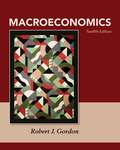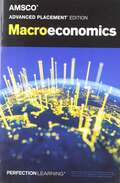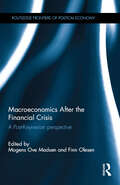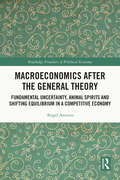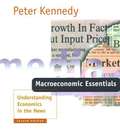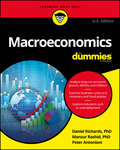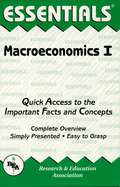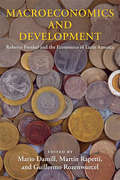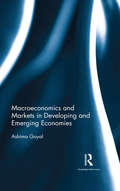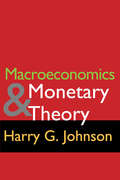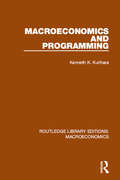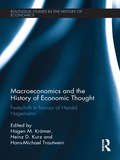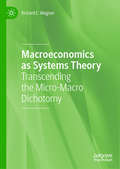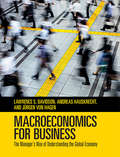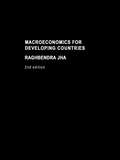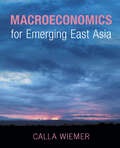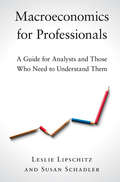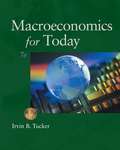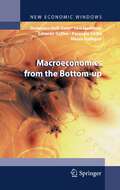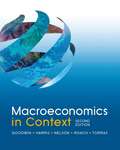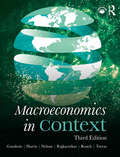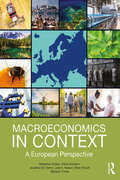- Table View
- List View
Macroeconomics (Twelfth Edition)
by Robert J. GordonMacroeconomics is widely praised for its ability to present theory as a way of evaluating key macro questions, such as why some countries are rich and others are poor.
Macroeconomics AMSCO Advanced Placement Edition
by AmscoWelcome to the study of macroeconomics. In this course, you will learn about the "Big Picture" aspects of economics--the elements that impact economies as a whole and how governments respond to challenges and opportunities within individual economies and across borders. You will find out how different economic systems function and an individual, household, or community level. (Here, the term community can mean a business, a neighborhood, a town, or a city.) In contrast, macroeconomics examines resources and power on a national, international, or global level. What follows is a quick look at how AP® course in general how countries with similar governmental structures can respond differently to economic shocks--both positive and negative. What is the difference between macroeconomics and microeconomics? Microeconomics examines the allocation of resources and economic decision-making on can benefit you, followed by the benefits of the macroeconomics course in particular.
Macroeconomics After the Financial Crisis: A Post-Keynesian perspective (Routledge Frontiers of Political Economy)
by Mogens Ove Madsen and Finn OlesenHow should Europe cope with the negative and still unfolding economic consequences of the current economic crisis? And why does Europe seem to be more conservative than the USA in dealing with the crisis? Since the outbreak of the current international economic crisis in 2008, the USA and many of the European countries have been tormented by high levels of unemployment and low levels of inflation, interest rates close to zero and fiscal policies of austerity. As such, the modern economic mainstream has been challenged by these empirical facts. Today, several years after the outbreak of the international economic crisis, supply side effects do not seem to be increasing employment as the modern mainstream claimed they would. Aggregate demand has to play a more important role in macroeconomic analysis than hitherto. That is, there is a need for alternative explanations of how a modern macro economy is expected to function and how the macroeconomic outcome could be manipulated by the right economic policy proposals. As expressed by the contents of the present book, a Post Keynesian understanding proposes such an alternative theoretically, methodologically and in terms of policy measures. This book will present new materials and approaches, especially new evidence and new views on the potential problems of public debt, the European Union and the present crisis, Central Banking, hysteresis in an agent based framework, the foundations of macroeconomics and the problems of uncertainty.
Macroeconomics After the General Theory: Fundamental Uncertainty, Animal Spirits and Shifting Equilibrium in a Competitive Economy (Routledge Frontiers of Political Economy)
by Angel AsensioBoth Keynes’s General Theory and orthodox economics seek to understand how competitive markets work, but they diverge sharply with respect to the nature and properties of the competitive equilibrium. The reason, as Keynes himself pointed out, is that the General Theory recognises that the future consequences of current decisions are fundamentally uncertain which, contra the orthodox view, radically affects decision-making and the functioning of markets.This book approaches macroeconomics on the basis of the General Theory, of which a new exposition is offered in the first part, purged of the grey areas that resulted from the context in which it was written, and of the considerable confusion generated for almost a century by the vain attempts of orthodox thinking to integrate such novel ideas in its deficient conceptual framework. The second part aims at extending the conceptual framework to the open economy and considering how uncertainty affects international linkages. The third part proposes an integrated conceptual and formal framework for analysing how changes in the national and international context, including macroeconomic policies, affect an economy.This new examination of General Theory is a major addition to the literature on Keynes, macroeconomics, economic theory and the history of economic thought.
Macroeconomics Essentials: Understanding Economics in the News (Second Edition)
by Peter KennedyWhat do we want our students to be able to do upon completing an introductory course in macroeconomics--shift curves on diagrams or interpret media commentary on the economy? This book, an effort to lead students in the latter direction, offers a clear exposition of introductory macroeconomic theory along with more than 600 one- or two-sentence "news clips" that serve as illustrations and exercises. The author calls this approach "media economics" to distinguish it from the encyclopedic character of traditional texts. The book provides a guide to what the author calls the "really important" ideas of macroeconomics, with a strong connection to the real world. Thus many instructors will find the book suitable for use in courses enrolling business students. The method of presentation allows room for topics that are crucial for the interpretation of news commentary, but given inadequate coverage in traditional macroeconomics texts. Examples include the many roles of nominal versus real interest rates, and international phenomena such as purchasing power parity. Despite its nontechnical presentation, the material in the book is quite challenging for students; to answer questions based on the news clips, students must truly understand the economic concepts and apply problem-solving skills rather than rote learning. This text, unlike other economic texts, provides the student with a practical yet sophisticated grasp of the macroeconomic principles necessary to interpret media commentary. The second edition has been revised and updated throughout.
Macroeconomics For Dummies
by Peter Antonioni Manzur Rashid Dan RichardsMacroeconomics For Dummies is the ideal resource for students in macro courses looking for a way to better understand and supplement their classwork. It is also perfect for readers with a general interest in expanding their general economics knowledge into the macroeconomics area. In 2011 and 2012, business was the single major with the greatest number of confirmed graduates. Macroeconomics (or a similarly named class) is a required course for every business or finance student at the college level.
Macroeconomics For Dummies - UK Edition
by Peter Antonioni Manzur Rashidifferent financial, business, consumer, and political factors interact to create the overall economic reality of nationsUnderstand business cycles, economic growth, and fiscal and monetary policiesStudy the relationships of various economic indicators, such as inflation, unemployment, and domestic outputGain a solid understanding of macroeconomics by building on microeconomic principles and using real-world examplesIf you're struggling with your economics course or you need to get up to speed on the topic of macroeconomics quickly, Macroeconomics For Dummies has you covered!
Macroeconomics I Essentials
by Robert RycroftREA's Essentials provide quick and easy access to critical information in a variety of different fields, ranging from the most basic to the most advanced. As its name implies, these concise, comprehensive study guides summarize the essentials of the field covered. Essentials are helpful when preparing for exams, doing homework and will remain a lasting reference source for students, teachers, and professionals. Macroeconomics I includes economic problems, demand and supply, economic systems, the private sector, the public sector, gross national product, macroeconomic problems, and macroeconomic models.
Macroeconomics and Development: Roberto Frenkel and the Economics of Latin America (Initiative for Policy Dialogue at Columbia: Challenges in Development and Globalization)
by Guillermo Rozenwurcel Mario Damill Martín RapettiLatin American neo-structuralism is a cutting-edge, regionally focused economic theory with broad implications for macroeconomics and development economics. Roberto Frenkel has spent five decades developing the theory's core arguments and expanding their application throughout the discipline, revolutionizing our understanding of high inflation and hyperinflation, disinflation programs, and the behavior of foreign exchange markets as well as financial and currency crises in emerging economies.The essays in this collection assess Latin American neo-structuralism's theoretical contributions and viability as the world's economies evolve. The authors discuss Frenkel's work in relation to pricing decisions, inflation and stabilization policy, development and income distribution in Latin America, and macroeconomic policy for economic growth. An entire section focuses on finance and crisis, and the volume concludes with a neo-structuralist analysis of general aspects of economic development. For those seeking a comprehensive introduction to contemporary Latin American economic thought, this collection not only explicates the intricate work of one of its greatest practitioners but also demonstrates its impact on the growth of economics.
Macroeconomics and Markets in Developing and Emerging Economies
by Ashima GoyalThe book presents and further develops basic principles and concepts in international finance and open economy macroeconomics to make them more relevant for emerging and developing economies (EDEs). The volume emphasises the necessity of greater knowledge of context as populous Asian economies integrate with world markets, as well as the rapidly changing nature of the area due to rethinking after the global financial crisis. It addresses a host of themes, including key issues such as exchange rate economics, macroeconomic policy in an open economy, analytical frameworks for and experience of EDEs after liberalisation, the international financial system, currency and financial crises, continuing risks and regulatory response. This book will be useful to scholars and researchers of economics, especially in macroeconomics, business and finance and development studies.
Macroeconomics and Markets in India: Good Luck or Good Policy?
by Ashima GoyalIndia was one of the better performers after the global financial crisis, and has done well despite opening out in a period of great international volatility. This book asks if this was due to luck or to good management. How much did macroeconomic policy contribute and did it do as much as it could have, on a reform path that was not standard? Are there any lessons from the Indian experience for the rest of the world? Senior Indian policy economists, market participants, and researchers address these interesting and important questions.There are those who think financial reform has gone too fast - relaxations in foreign borrowing norms exposed firms to external shocks. Volatile capital flows impacted markets, although more liberalization of risk-sharing equity compared to debt flows, was effective in reducing domestic risk. But there are also those who think reform was too slow - choking financial development: many markets and instruments that could improve domestic financial intermediation and reduce risk were held back. Analysis suggests policy was able to find the correct timing, pace and combination of reforms and of caution, but improvement is always possible. Luck and inherent strengths of the economy helped absorb both policy mistakes and external shocks. This book was originally published as a special issue of Macroeconomics and Finance in Emerging Market Economies.
Macroeconomics and Monetary Theory
by Harry G. JohnsonMacroeconomics is an outgrowth from the main stream of classical monetary theory following Keynes. Keynes changed the emphasis from determination of the level of money prices to determination of the level of output and employment. He also changed the key relationship from demand and supply of money as determining the price level to the relationship between consumption expenditure and income, in conjunction with private investment expenditure, as determining the level of output and therefore employment demanded. The income multiplier replaced the velocity of circulation as the key concept of monetary theory. The tendency of the past twenty-five years has been to reintegrate Keynesian and classical monetary theory into one general system of analysis. Moreover, as inflation has succeeded mass unemployment as a major policy problem, interest in classical monetary theory has revived, while Keynesians have increasingly' emphasized the monetary aspects of Keynesian theory. The proper contemporary distinction is not between two separate branches of economic theory, but between two areas of application or contexts of the theory of rational maximizing behavior. In the one (the microeconomic) context, it is assumed either that the overall workings of the economic system can be disregarded, or that the macroeconomic relationships are in full general equilibrium. In the other (the macroeconomic) context, it is assumed that the maximizing decisions of individual economic units (firms and households) will not necessarily add up to a macroeconomic equilibrium, but will produce a disequilibrium situation that will in the course of time produce changes in the individual decisions.
Macroeconomics and Programming (Routledge Library Editions: Macroeconomics)
by Kenneth K. KuriharaThis volume, originally published in 1964, is intended for students of macroeconomic theory and mathematical programming. Part 1 includes critical discussion of debates from the 1950s and 60s in the related fields of income-employment , trade cycles and general prices, with an ultimate view to extending macroeconomic analysis and policy beyond the conventional purview; Part 2 suggests various possible macro applications of mathematical programming techniques to optimization problems, with a secondary view to forwwarding the synthesis of aggregative economic theory and multisectoral input-output analysis.
Macroeconomics and the History of Economic Thought: Festschrift in Honour of Harald Hagemann (Routledge Studies in the History of Economics #144)
by Hans-Michael Trautwein Heinz D. Kurz Hagen M. KrämerThe essays in this Festschrift have been chosen to honour Harald Hagemann and his scientific work. They reflect his main contributions to economic research and his major fields of interest. The essays in the first part deal with various aspects within the history of economic thought. The second part is about the current state of macroeconomics. The essays in the third part of the book cover topics on economic growth and structural dynamics.
Macroeconomics as Systems Theory: Transcending the Micro-Macro Dichotomy
by Richard E. WagnerThis book examines macroeconomic theory from an analytical framework provided by theories of complex systems, in contrast to conventional theories founded on aggregation. The resulting difference in analytical perspectives is huge: the macro level of society is not pursued through aggregation over micro entities. To the contrary, the micro-macro relation is treated as one of parts-to-whole, and this relation is approached from within an ecological scheme of thought. A society is a complex ecology of plans. That ecology, however, is not reducible to a single plan. Conventional macro theory presents a national economy as a collection of such aggregate variables as output, employment, investment, and a price level, and seeks to develop theoretical relationships among those variables. In contrast, the social-theoretic approach to macro or social theory in this book treats the standard macro variables as having been shaped through social institutions, conventions, and processes that in turn are generated through interaction among economizing persons. The object denoted as macro is thus of a higher order of complexity than the object denoted as micro.
Macroeconomics for Business: The Manager's Way of Understanding the Global Economy
by Lawrence S. Davidson Andreas Hauskrecht Jürgen von HagenInterpreting and applying macroeconomic analysis to the global economic environment and understanding the tools used to do so is fundamental to making good managerial decisions. Presuming no background in economic theory and prioritizing international application, this textbook introduces macroeconomics to business students. It explains how to understand domestic and global macroeconomic developments, policies, and data, and makes extensive use of case studies and data sets to present modern macroeconomics in a globalized world. Each chapter has several specific data exercises and practices as well as an international application focusing on the global perspective. By providing a host of international material, this book is useful for instructors and students around the globe.
Macroeconomics for Developing Countries
by Raghbendra JhaThis comprehensively revised and updated edition develops the themes presented in the first edition. Students and teachers who are familiar with the book will notice entirely new chapters as well as significant revision and uptating of existing chapters to take into account global economic changes since the turn of the millennium. With qu
Macroeconomics for Emerging East Asia
by Calla WiemerMacroeconomics for Emerging East Asia presents a distinctive approach to the study of macroeconomic theory and policy. The author develops a unique analytical framework that incorporates: (1) both internal and external balance as aspects of macroeconomic stability; (2) both the exchange rate and the interest rate as monetary policy instruments, (3) government debt sustainability as a concern of fiscal policy, and (4) global capital flows as a force to be reckoned with. The framework provides students with the foundational knowledge to analyze macroeconomic issues common to emerging economies. Concepts are illustrated using the latest empirical data and extensive case study analysis for thirteen economies of Northeast and Southeast Asia (Cambodia, China, Hong Kong, Indonesia, Korea, Laos, Myanmar, Malaysia, the Philippines, Singapore, Taiwan, Thailand, and Vietnam). The book's lucid exposition accommodates students of differing levels of preparation.
Macroeconomics for Professionals: A Guide for Analysts and Those Who Need to Understand Them
by Susan Schadler Leslie LipschitzUnderstanding macroeconomic developments and policies in the twenty-first century is daunting: policy-makers face the combined challenges of supporting economic activity and employment, keeping inflation low and risks of financial crises at bay, and navigating the ever-tighter linkages of globalization. Many professionals face demands to evaluate the implications of developments and policies for their business, financial, or public policy decisions. Macroeconomics for Professionals provides a concise, rigorous, yet intuitive framework for assessing a country's macroeconomic outlook and policies. Drawing on years of experience at the International Monetary Fund, Leslie Lipschitz and Susan Schadler have created an operating manual for professional applied economists and all those required to evaluate economic analysis.
Macroeconomics for Today
by Irvin B. TuckerIn this book, Irvin Tucker presents Macro and Micro economic concepts using a writing style that is engaging and clear, no matter what your current level of economic understanding. A unique presentation and visual learning system, colorful graphs and Causation Chains clarify and illustrate important economic principles. The book concisely presents and reinforces core concepts, while online resources immediately facilitate assessment of understanding, and will study the latest information on economic growth, income distribution, federal deficits, environmental issues, and other developments in economics today. The book's easy-to-follow format demonstrates how to apply principles to your everyday life, while numerous printed and digital study tools help you further master key current economic principles.
Macroeconomics for Today (7th Edition)
by Irvin B. TuckerHelp today's learner visualize macroeconomics in action with the most pedagogically rich, complete book available--Tucker's MACROECONOMICS FOR TODAY, Seventh Edition. A quick look at this engaging, dynamic text will show you why this is the book that is famous for helping readers at all levels of skill and preparation grasp and master economic principles. Written by an award-winning educator, recognized for his work in relating basic economic principles to global issues, Irvin Tucker's MACROECONOMICS FOR TODAY continues its unique textual and visual learning system. This edition concisely presents and reinforces core concepts, then immediately assesses student comprehension. You will find the latest economic information on federal deficits, the stimulus package, environmental issues, and other developments presented in an engaging, easy-to-follow format applicable to everyday life. MACROECONOMICS FOR TODAY, Seventh Edition, provides a full complement of instructor resources, including a handy Instructor's Resource CD, new PowerPoint? slides, optional CourseMate website, and complete array of videos.
Macroeconomics from the Bottom-up
by Saul Desiderio Edoardo Gaffeo Pasquale Cirillo Domenico Delli Gatti Mauro GallegatiThis book arose from our conviction that the NNS-DSGE approach to the analysis of aggregate market outcomes is fundamentally flawed. The practice of overcoming the SMD result by recurring to a fictitious RA leads to insurmountable methodological problems and lies at the root of DSGE models' failure to satisfactorily explain real world features, like exchange rate and banking crises, bubbles and herding in financial markets, swings in the sentiment of consumers and entrepreneurs, asymmetries and persistence in aggregate variables, and so on. At odds with this view, our critique rests on the premise that any modern macroeconomy should be modeled instead as a complex system of heterogeneous interacting individuals, acting adaptively and autonomously according to simple and empirically validated rules of thumb. We call our proposed approach Bottom-up Adaptive Macroeconomics (BAM). The reason why we claim that the contents of this book can be inscribed in the realm of macroeconomics is threefold: i) We are looking for a framework that helps us to think coherently about the interrelationships among two or more markets. In what follows, in particular, three markets will be considered: the markets for goods, labor and loanable funds. In this respect, real time matters: what happens in one market depends on what has happened, on what is happening, or on what will happen in other markets. This implies that intertemporal coordination issues cannot be ignored. ii) Eventually, it's all about prices and quantities. However, we are mostly interested in aggregate prices and quantities, that is indexes built from the dispersed outcomes of the decentralized transactions of a large population of heterogeneous individuals. Each individual acts purposefully, but she knows anything about the levels of prices and quantities which clear markets in the aggregate. iii) In the hope of being allowed to purport scientific claims, BAM relies on the assumption that individual purposeful behaviours aggregates into regularities. Macro behaviour, however, can depart radically from what the individual units are trying to accomplish. It is in this sense that aggregate outcomes emerge from individual actions and interactions.
Macroeconomics in Context: A European Perspective
by Jonathan Harris Neva Goodwin Julie A. Nelson Brian Roach Mariano TorrasMacroeconomics in Context lays out the principles of macroeconomics in a manner that is thorough, up to date, and relevant to students. Like its counterpart, Microeconomics in Context, the book is attuned to economic realities--and it has a bargain price. The in Context books offer affordability, engaging treatment of high-interest topics from sustainability to financial crisis and rising inequality, and clear, straightforward presentation of economic theory. Policy issues are presented in context--historical, institutional, social, political, and ethical--and always with reference to human well-being.
Macroeconomics in Context: A European Perspective
by Neva Goodwin Jonathan M. Harris Julie A. Nelson Brian Roach Mariano Torras Pratistha Joshi RajkarnikarMacroeconomics in Context lays out the principles of macroeconomics in a manner that is thorough, up to date, and relevant to students. Like its counterpart, Microeconomics in Context, the book is uniquely attuned to economic realities. The "in Context" books offer engaging coverage of current topics including financial crises, rising inequality, debt and deficits, and environmental sustainability, while also providing a clear and accessible exploration of economic theory and applications. The third edition features: Clear explanations of basic economic concepts alongside more in-depth analysis of macroeconomics models and economic activity Expanded coverage of topics including, inequality, financialization and debt issues, the changing nature of jobs, and sustainable development Thoroughly updated figures and data A full complement of online instructor and student support materials such as additional tables and data, PowerPoint slides and a study guide This engaging textbook offers students an excellent guide to macroeconomics. The latest addition to the "In Context" series, it combines real-world relevance with a thorough grounding in multiple economic paradigms.
Macroeconomics in Context: A European Perspective
by Neva Goodwin Jonathan M. Harris Julie A. Nelson Brian Roach Mariano Torras Sebastian Dullien<p>Macroeconomics in Context: A European Perspective lays out the principles of macroeconomics in a manner that is thorough, up to date, and relevant to students. With a clear presentation of economic theory throughout, this latest addition to the bestselling "In Context" set of textbooks is written with a specific focus on European data, institutions, and historical events, offering engaging treatment of high-interest topics, including sustainability, Brexit, the euro crisis, and rising inequality. Policy issues are presented in context (historical, institutional, social, political, and ethical), and always with reference to human well-being. This book is divided into four parts, covering the following key issues: <p> <li>The context of economic analysis, including basic macroeconomic statistics and tools; <li>The basics of macroeconomic measurements, including GDP, inflation, and unemployment, as well as alternative measures of well-being, and the particular structures of the European economies; <li>Methods for analyzing monetary and fiscal policy, including an in-depth coverage of the instruments and approaches of the European central bank and some coverage of an open economy; <li>The application of the tools learnt to selected macroeconomic issues, such as the euro crisis, the global financial crisis, public debt, global development, and environmental sustainability. </li> <p> <p>Far more than any other existing macroeconomic textbook, this book combines real-world relevance of the topics covered with a strong focus on European institutions and structures within an approach that explains multiple economic paradigms. This combination helps to raise students’ interest in macroeconomics as well as enhance their understanding of the power and limitation of macroeconomic analysis. Visit www.gdae.org/europeanmacro/ for online resources for both lecturers and students. </p>
